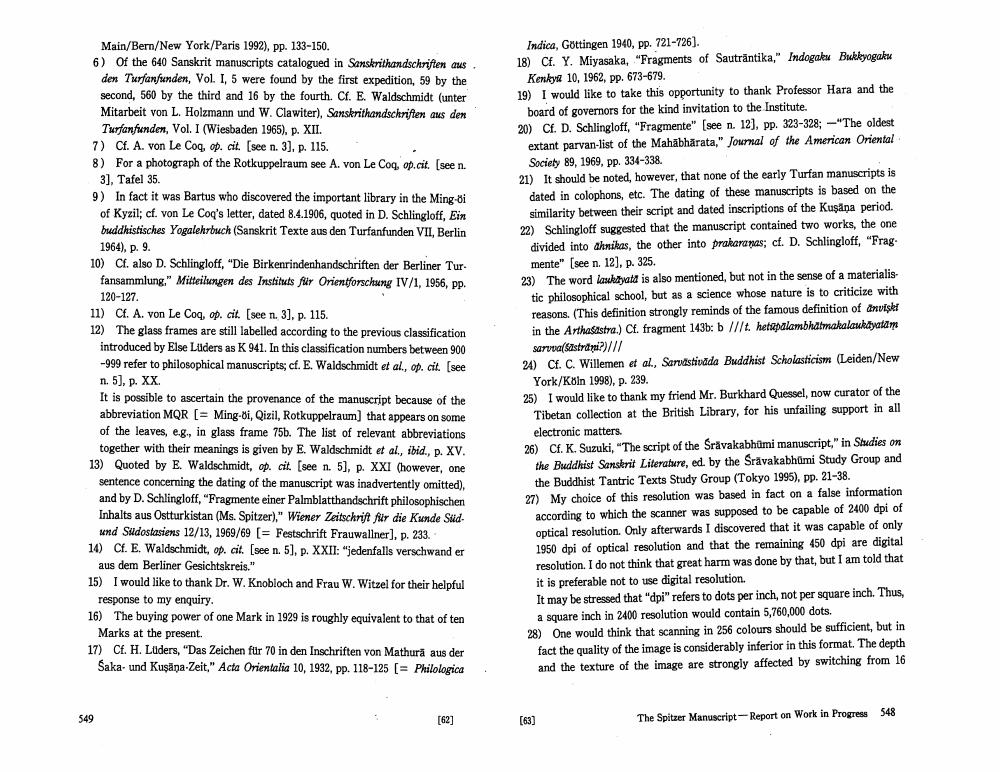Book Title: Spitzer Manuscript Report On Work In Progress Author(s): Eli Franco Publisher: Eli Franco View full book textPage 8
________________ Main/Bern/New York/Paris 1992), pp. 133-150. 6) Of the 640 Sanskrit manuscripts catalogued in Sanskrithandschriften aus den Turfanfunden, Vol. I, 5 were found by the first expedition, 59 by the second, 560 by the third and 16 by the fourth. Cf. E. Waldschmidt (unter Mitarbeit von L. Holzmann und W. Clawiter), Sanskrithandschriften aus den Turfanfunden, Vol. I (Wiesbaden 1965), p. XII. 7) Cf. A. von Le Coq, op. cit. [see n. 3], p. 115. 8) For a photograph of the Rotkuppelraum see A. von Le Coq, op. cit. [see n. 3], Tafel 35. 9) In fact it was Bartus who discovered the important library in the Ming-di of Kyzil; cf. von Le Coq's letter, dated 8.4.1906, quoted in D. Schlingloff, Ein buddhistisches Yogalehrbuch (Sanskrit Texte aus den Turfanfunden VII, Berlin 1964), p. 9. 10) Cf. also D. Schlingloff, "Die Birkenrindenhandschriften der Berliner Turfansammlung." Mitteilungen des Instituts für Orientforschung IV/1, 1956, pp. 120-127. 11) Cf. A. von Le Coq, op. cit. [see n. 3], p. 115. 12) The glass frames are still labelled according to the previous classification introduced by Else Lüders as K 941. In this classification numbers between 900 -999 refer to philosophical manuscripts; cf. E. Waldschmidt et al., op. cit. [see n. 5], p. XX. It is possible to ascertain the provenance of the manuscript because of the abbreviation MQR [= Ming-di, Qizil, Rotkuppelraum] that appears on some of the leaves, e.g., in glass frame 75b. The list of relevant abbreviations together with their meanings is given by E. Waldschmidt et al., ibid., p. XV. 13) Quoted by E. Waldschmidt, op. cit. [see n. 5], p. XXI (however, one sentence concerning the dating of the manuscript was inadvertently omitted), and by D. Schlingloff, "Fragmente einer Palmblatthandschrift philosophischen Inhalts aus Ostturkistan (Ms. Spitzer)," Wiener Zeitschrift für die Kunde Südund Südostasiens 12/13, 1969/69 [ Festschrift Frauwallner], p. 233. 14) Cf. E. Waldschmidt, op. cit. [see n. 5], p. XXII: "jedenfalls verschwand er aus dem Berliner Gesichtskreis." 15) I would like to thank Dr. W. Knobloch and Frau W. Witzel for their helpful response to my enquiry. 16) The buying power of one Mark in 1929 is roughly equivalent to that of ten Marks at the present. 17) Cf. H. Lüders, "Das Zeichen für 70 in den Inschriften von Mathura aus der Saka- und Kuşăpa-Zeit," Acta Orientalia 10, 1932, pp. 118-125 [= Philologica 549 [62] Indica, Göttingen 1940, pp. 721-726]. 18) Cf. Y. Miyasaka, "Fragments of Sauträntika," Indogaku Bukkyogaku Kenky 10, 1962, pp. 673-679. 19) I would like to take this opportunity to thank Professor Hara and the board of governors for the kind invitation to the Institute. 20) Cf. D. Schlingloff, "Fragmente" [see n. 12], pp. 323-328; -"The oldest extant parvan-list of the Mahabharata," Journal of the American Oriental Society 89, 1969, pp. 334-338. 21) It should be noted, however, that none of the early Turfan manuscripts is dated in colophons, etc. The dating of these manuscripts is based on the similarity between their script and dated inscriptions of the Kuşăņa period. 22) Schlingloff suggested that the manuscript contained two works, the one divided into ahnikas, the other into prakaranas; cf. D. Schlingloff, "Frag mente" [see n. 12], p. 325. 23) The word laukyata is also mentioned, but not in the sense of a materialistic philosophical school, but as a science whose nature is to criticize with reasons. (This definition strongly reminds of the famous definition of anviski in the Arthasastra.) Cf. fragment 143b: b ///t. hetapalambhätmakalaukāyatām sarvva(sāsträni?)||| 24) Cf. C. Willemen et al., Sarvästivada Buddhist Scholasticism (Leiden/New York/Köln 1998), p. 239. 25) I would like to thank my friend Mr. Burkhard Quessel, now curator of the Tibetan collection at the British Library, for his unfailing support in all electronic matters. 26) Cf. K. Suzuki, "The script of the Śrävakabhumi manuscript," in Studies on the Buddhist Sanskrit Literature, ed. by the Srävakabhumi Study Group and the Buddhist Tantric Texts Study Group (Tokyo 1995), pp. 21-38. 27) My choice of this resolution was based in fact on a false information according to which the scanner was supposed to be capable of 2400 dpi of optical resolution. Only afterwards I discovered that it was capable of only 1950 dpi of optical resolution and that the remaining 450 dpi are digital resolution. I do not think that great harm was done by that, but I am told that it is preferable not to use digital resolution. It may be stressed that "dpi" refers to dots per inch, not per square inch. Thus, a square inch in 2400 resolution would contain 5,760,000 dots. 28) One would think that scanning in 256 colours should be sufficient, but in fact the quality of the image is considerably inferior in this format. The depth and the texture of the image are strongly affected by switching from 16 [63] The Spitzer Manuscript-Report on Work in Progress 548Page Navigation
1 ... 6 7 8 9 10
